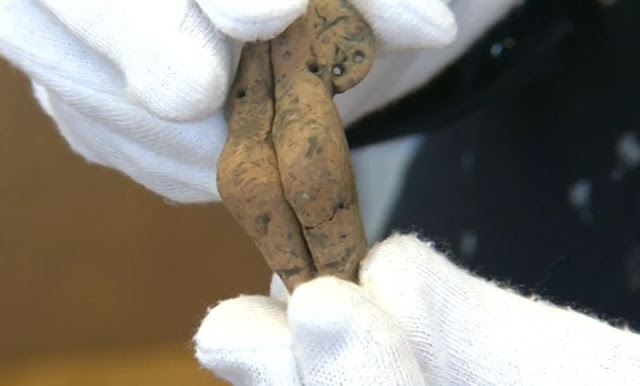This unique Venus, dating from the final Neolithic or the first phase of the Chalcolithic, was found thanks to preventive excavations linked to the imminent construction of a ring road in the Silesian capital. Only the lower part of the statuette, with legs, accentuated hips and belly, has survived. The terracotta torso measures about six centimetres.
 |
| The Venus d' Opava [Credit: CT24] |
According to archaeologists of the local branch of the Academy of Sciences, the statuette, created around 4,200 BC by the people of Lengyel's culture, covering mainly Hungary, Slovakia and Upper Silesia, served as a pagan cult object. For archaeologist Kateřina Papáková, the dig manager, it is an exceptional discovery: "Several torsos of Palaeolithic female statuettes were discovered in the 1980s in Velké Hoštice, in the region of Opava. But these torsos differ from our Venus in their form. The statuette we discovered bears features of Eastern European cultures, specifically the Trypillia culture of the territory of present-day Ukraine."
The Venus d' Opava, which looks like the famous Venus de Věstonice, the oldest ceramic figurine in the world discovered in South Moravia, is less robust than the other female statuettes found in the Czech territory.
 |
| The Venus d' Opava [Credit: CT24] |
The discovery of the figurine is the fruit of chance. The excavations in Opava, during which archaeologists uncovered part of a prehistoric settlement, including four buried huts, were completed last October. Archaeologists at the Academy of Sciences have found a multitude of objects on the site, such as ceramic fragments, various tools and weights for fishing nets. Covered with a good layer of mud, the prehistoric statuette was not discovered until last week, however, when the cataloguing of the finds took place.
"During the course of this year, the statuette will be subjected to various analyses" explains Kateřina Papáková. "We also want to make a three-dimensional model using a 3D scanner. And as of next year, the Venus, as well as other objects found during excavations, could be on display to the public."
Source: Czech Radio [February 12, 2018]


